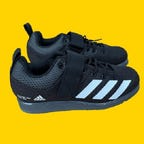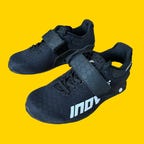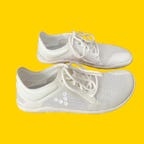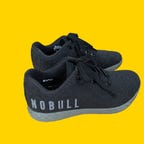Best Weight-Lifting Shoes for 2024
Getting the proper gear is important for any workout, including weightlifting. We've picked the best weightlifting shoes for you, whether you're a new lifter or an experienced CrossFitter.
What to consider
Type
Fit
Versatility
Our Picks


Whether you're a powerlifter, CrossFit enthusiast, or just a casual lifter looking to stay fit, a pair of weight-lifting shoes will make a huge difference in your technique. You will want to look for a shoe that gives you stability and allows you to improve your depth. There are a lot of shoes designed for working out, so to help you find the best, we've narrowed it down.
Shopping for weightlifting shoes isn't quite the same as looking for a pair of regular shoes. We spoke to several experts to find out what you should be looking for if you're interested in buying a pair of weightlifting shoes. Based on their advice and our own testing, we've rounded up the best lifting shoes on the market. If you've been lifting regularly and want to step up your game, then these may help you get closer to your goals. Below is a list of the best weightlifting shoes we tried out.
What are the best overall weight-lifting shoes?
The best weight-lifting shoe for you will depend on the type that fits your needs: raised heel or flat sole. We recommend the Adidas Powerlift 5 for beginners, or Converse Chuck Taylor Low Tops as a classic go-to.
Best weight-lifting shoes of 2024
Many years ago when I bought my first pair of lifting shoes, I chose an older version of Adidas Powerlift shoes. At the time, the pair I had was stiff and heavy, and the material didn't seem to be the best. This time around, I tested the Adidas Powerlift 5 weight-lifting shoes, and I'm happy to report that they've improved in more ways than one. The shoe has some weight to it, which I expected in this style, but it's lighter compared to the older version I had.
The shoes do seem to run a little on the small side, so unless you have a narrow or small foot, I'd size up for a more comfortable fit. This shoe has plenty of stability around the ankles and the profile is low, so it technically doesn't have the same high, wedged heel that many weightlifting shoes have. Instead, it has a midfoot stability wedge measuring 34 millimeters, which I think is a safe option if you aren't sure if you're ready to commit to a full heel yet.
The upper and toe box is a durable and flexible canvas with mesh ventilation inserts, so it's not stiff and is breathable. A bonus is that, if you're trying to shop more sustainably, you'd be pleased to know that this shoe is made of recycled materials.
I tested this shoe during my leg day routine, which usually includes barbell back squats, split squats, deadlifts and hip thrusts. What I liked about these shoes is that they were flexible enough to use for split squats without feeling restrictive. Sometimes toe boxes on weightlifting shoes can be stiff and uncomfortable during exercises where your toes require flexing.
I liked that I was able to use this shoe throughout my whole routine without hesitation. Squatting felt comfortable and more natural with a bit of a heel, and my feet felt secure, thanks to the rubber soles. If you're just getting your feet wet in weightlifting, the Adidas Powerlift 5 shoes are a good place to start.
Best weight-lifting shoes for heavy squats
Inov-8 Fastlift Power G 380
If you're an experienced powerlifter or CrossFitter, the Inov-8 Fastlift Power G 380 is calling your name. This is a surprisingly lightweight yet strong-performing squat shoe. Inov-8 is the first brand to use graphene in its shoes. Graphene is one of the toughest materials to exist, 200 times stronger than steel. It would also explain why this shoe is the most expensive on the list, at over $200. You're paying for top-quality material that is intended to be extra durable. The power heel and outsole are made of graphene rubber, which provides excellent support and stability.
The toe box is made up of a flexible and breathable material, which is important as you quickly transition through exercises such as snatches or hang cleans. These squat shoes fit true to size for me, but the toe box is narrow, so I'd recommend sizing up if you have wide feet.
I tested these squat shoes while back and front squatting and was impressed at the depth I was able to hit with the assisted help. I even felt confident enough to squat heavier with the new range of motion and stability the shoes gave me. I could see taller people or those with mobility limitations benefitting from this shoe when they squat. If you're trying to hit new PRs in the weight room, then this is a solid pick to wear on your heavy-volume squat days.
Best minimalist weight-lifting shoes
Vivobarefoot Primus Lite III
Once upon a time, I used to lift weights barefoot because it was convenient. Barefoot training also has many benefits but it's not for everyone, and it can also put your feet at risk for injury around heavy equipment. That's where minimalist shoes come in. Vivobarefoot's minimalist shoe moves with you and feels as close to being barefoot as possible. The Vivobarefoot Primus Lite III was designed to be stable and flexible and to be used for all workouts, including weight lifting.
The Vivobarefoot Primus Lite III is lightweight and its toe box is wide and round to perfectly fit the shape of your foot. The rubber active outsole is only 2 millimeters thick, but it provides an excellent grip on the ground. The shoe is also sustainable -- when you're done wearing them, send them back to Vivobarefoot to recycle into a new pair of shoes.
The downside to this shoe is that there are few half sizes, so I had to get the next full size up, which was slightly big for me. I used Vivobarefoot's Strutfit measurement app, which allows you to virtually find out your best shoe size. To do so, you take a picture of your foot and then you submit it to determine the size that should be your best fit. I would size down next time, but it would be beneficial if Vivobarefoot included more half sizes.
Despite the sizing discrepancy, I was still able to wear these shoes comfortably. I'd recommend this style for experienced or intermediate lifters who are used to exercising barefoot, since this may take some adjusting for a novice lifter. I wouldn't suggest this style for Olympic lifting because it won't provide the same support an elevated shoe would for certain exercises.
I'd never tried a minimalist shoe before so this was a new experience for me. Initially, I wasn't sure about the design but was pleased with how the shoe functioned during testing. It felt secure and comfortable doing conventional and sumo deadlifts, and it felt natural while doing back squats and didn't feel like I needed a heel. I even used these shoes during my upper bodywork day and had no issues.
Best classic weight-lifting shoes
Converse Chuck Taylor All Star Low Tops
If you want a trusty weight-lifting shoe that doesn't break the bank, then the classic Converse Chuck Taylor All Stars is a solid choice. I've lifted in these for years because the flat sole and ankle support makes for a good lifting shoe. I also like that the brand offers various colors and high tops if you prefer those over low tops.
I'm able to use these shoes equally for squats and deadlifts without worrying about slipping around on the platform. I wouldn't recommend this shoe if you plan on doing Olympic lifts since you'd benefit from a more flexible shoe for those exercises.
The only negative thing about Converse shoes is that the toe box may run small, so if you have a wide foot you'll want to make sure to order your shoes in a size wide. I can get away with the standard style, but there have been instances when I've felt them to be tight around my pinky toes.
If you're not looking to shell out over $100 on weight-lifting shoes and only plan on doing traditional lifting, then the Converse Chuck Taylor All-Star shoe is a good choice. Another trick I've learned is that if you have a smaller shoe size (like my size 6.5 foot), you can even get away with buying the shoe in a Big Kids style and paying $20 less.
Best versatile weight-lifting shoes
Nobull Black Ivy Trainer
Nobull launched in 2014 and has since made a name for itself in the weight-lifting community. The majority of Nobull's shoes are intended for lifting or training, and they even have lifting pairs with raised heels and running shoes. I tested the Black Ivy Trainer, which is designed to be used for weight lifting and cross-training.
The shoe is stylish, true to size and snug in the toe box, but didn't feel as tight as some of the other shoes I tested. The rubber sole design has a 4-millimeter heel-to-toe drop, which makes it flat all around. The upper was my favorite aspect of the shoe design. It's made up of a SuperFabric that claims to be extremely durable, breathable and abrasion-resistant. You can tell that the shoe was made to be able to handle tough workouts and won't fall apart after a few uses. There are also SuperFabric guard plates, placed on a flexible mesh base layer, that look like small dots surrounding the shoe and are intended to create a shield for rope climbs or other exercises that require an exterior grip as part of your workouts.
I tested these during both upper-body and lower-body workouts, and my ankles and arches felt extra secure during my lifts. I felt grounded and steady during deadlifts and squats, and the shoe is flexible enough to work for single-leg exercises or plyometrics. I'd recommend these to Converse wearers who are looking to change up their shoes for a similar yet more versatile design.
Best alternative cross-training shoes
Altra Solstice XT2
Because weight-lifting shoes run to fit your exact shoe size, I also looked for a cross-training shoe that would be comfortable for lifters with wide feet. From the ones I tested, I found the Altra Solstice XT2 to be the best fit. My problem with some of the cross-trainers I tested was that they were either too snug in the toe box, didn't have the right amount of grip on the sole, or were tight around the top of the foot. The Altras were that happy medium where the toes had room to spread but also had a balanced cushion platform that supported the heel and forefoot and had ankle and arch support. The upper is made up of a breathable mesh that makes the shoes extra flexible and easy to transition to different exercises.
It doesn't hurt that it's a stylish shoe so it can be worn outside of the gym as well. I tested these shoes with squats, deadlifts and then a HIIT workout that included medicine ball throws and slams, squat jumps and jumping jacks.
My only problem with these shoes is that the laces seem to be on the thin and short side, which causes them to untie easily so you have to make sure to double-knot them. Another aspect I noticed was that the mesh on the toe box tends to lose shape when it's not in use. I'd recommend keeping the tissue paper that lines the shoe to help keep the shape in check. Otherwise, if you're looking for an alternative cross-trainer that is wide-foot friendly, the Altras are a good place to start.
How we tested weight-lifting shoes
Comfort: Weight-lifting shoes are usually snug, so we made sure our feet still felt comfortable.
Shoe type: We tested weight-lifting shoes that are heeled, flat-soled or a cross-training style to see which worked best for weight-lifting.
Support: We looked at how supportive the shoe is around the ankles, if the sole has a good grip, and flexibility.
Function: We tested while doing traditional weight-lifting exercises to determine if the shoe functions as promised.
Other weight-lifting shoes we tried
Under Armour UA HOVR Omnia: Compared to the other weight-lifting and cross-training shoes tested, the Under Armour UA HOVR Omnia felt smaller in the toe box and the upper felt tight. This shoe also had more cushioning, which works for other forms of cross-training exercises but doesn't lend itself to weight-lifting.
Under Armour UA TriBase Reign 4 Training Shoes: I questioned the durability of this shoe because of the design on the upper. It's made of a lightweight, breathable mesh, but it looks delicate and the holes on the design are slightly large, which makes me question how easily it might get snagged on something. Another negative was that the grip on the sole wasn't the best and I could feel my feet slipping while going heavier on the leg press and doing chest-supported rows. If you opt for this style, I'd only recommend it for light weight lifting.
Reebok Legacy Lifter II Women's Weight-lifting Shoes: Of all the heeled weight-lifting shoes I tried, this style felt the least comfortable. It could use more toe room because it's a narrow shoe and would not work for someone with wide feet. The insole on my left foot kept digging into my arch, which I thought might be due to a design defect or a sizing problem. And even though the shoes worked for squatting, it was the highest-heeled and heaviest shoes I tested, which some people may not like. The material also didn't seem as durable or flexible as the Inov-8 or Adidas Powerlift.
Hylete Circuit II Cross-Training: This style was noticeably spacious in the toe box and more flexible, which can be a good thing for those with wider feet, but I found it to be distracting while exercising. This shoe in particular is unique because it comes with three insoles that you can switch out for different types of activities, such as lifting, cross-training and running. The shoe was decent for lifting and cross-training, but I also tested it for running and found it would not be suitable for all runners. The insole lacked support and felt uneven, but could be improved with extra insoles to fit different foot arches.
How to pick weight-lifting shoes
Because weight-lifting shoes are a unique type of footwear, we got feedback from experts on the qualities we should be looking for when shopping for these shoes.
They are true to size: Weight-lifting shoes tend to run true to size to fit your exact foot measurements. "This is because you don't want to move around inside the shoe at all when squatting or Olympic lifting, since the shoe should solidly move with you through your lift," explains Matt Scarfo, a National Academy of Sports Medicine certified personal trainer.
Additionally, you want to make sure the shoe is stable and supportive. "They shouldn't be too comfortable to walk around in, because the platform of the shoe should be rigid so you can put all your force through the shoe into the floor," says Scarfo.
Phung D. Tran, an American College of Sports Medicine certified exercise physiologist, adds that if you have wide feet, it is completely OK to go up half a size so the shoe sits more comfortably. "Also keep in mind, weight-lifting shoes do not help with flat feet as much, since they provide no cushion for the soles," Tran explains, adding, "It's up to you to do exercises to improve your arch and calf muscles' strength."
"Don't shop by brand; shop by fit, because you need to try on shoes from a variety of brands to see which ones feel the best to you," says Tran. "It doesn't matter how cool the shoe looks or how many high-tech features it has, because if they aren't comfortable, your workouts will become a struggle," she points out. Keep in mind when shopping for weight-lifting shoes that comfort and stability are key.
Raised-heel shoes: One of the styles of weight-lifting shoes you'll come across has a raised heel. These usually have laces and a Velcro strap across the top to keep your feet extra secure. These shoes are best if you practice Olympic lifting exercises that include clean-and-jerks or snatches. It's also beneficial if you're doing exercises like squatting and trying to get deeper in your squat. "Heeled weight-lifting shoes help those with limited ankle mobility by elevating the heels and decreasing the angle between the shin and the top of the foot, improving squat depth," explains Scarfo. He says you should only use these shoes for squatting and Olympic lifting as they provide a stable base for dropping into a squat and engaging the hamstrings to lift out of it.
That's all they're good for. "You absolutely do not want to use heeled weight-lifting shoes for deadlifting, because these shoes can move your center-of-gravity forward, causing you to use too much of your back to deadlift, and increasing risk of injury," he warns.
Flat-sole shoes: There also are weight-lifting shoes that fall under the flat-sole or minimalist shoe category. These are solid, flat and have a zero-drop sole, which means there is no height difference between the heel and toe. "Look for good ankle support, excellent grip and a flexible sole if you opt for a minimalist training shoe," says Tran. The flexible sole will help optimize performance in everything from plyometrics to heavy lifts.
This style tends to be more versatile because, unlike the heeled weight-lifting shoe, it can be used for all your lifts and even cardio exercises. "However, these won't help you drop into a squat without a little stretching," says Scarfo. But this doesn't mean it's impossible to have the proper ankle flexion needed to squat without heels. He suggests foam rolling, stretching your calves and doing plenty of ankle stretches to prepare your Achilles tendon ahead of your lifting sessions. This should also include a long warmup, so your body is prepared to stabilize your ankles during these workouts.
Factors to consider when choosing weight-lifting shoes
Consider going to a shoe store first and getting professionally measured to make sure you're getting the best fit and style to suit your needs. Weight-lifting shoes can be expensive, especially with brand names that are well known to specifically design them. You could easily shell out over $100 on a pair of shoes, but they'll last you a long time.
Additionally, the types of weight-lifting you're going to be doing will determine the right style for you. Raised-heel shoes may work best if you're a CrossFitter trying to perfect your barbell snatches or squat past parallel, but they may limit any other form of lifting. If you aren't a serious weight lifter and just want to have a better shoe for your strength training sessions, then a flat-sole shoe may be a better pick. A bonus is that many of these can be used for other activities as well.




